[ad_1]
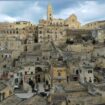
Go World Travel is reader-supported and may earn a commission from purchases made through links in this piece.
The street under my feet seamlessly changed to smooth, sand-coloured cobbles, the same colour as the higgledy-piggledy stone houses around me. Big green cacti, fuzzy cycad palms and bright red cyclamen flowers stood upright in terracotta pots outside front doors, up narrow stairways and along balconies.
The air was warm and the winding side streets called to me. But for now, I was on a mission to find some cornetti (croissants) for breakfast.
The street opened onto a sleepy piazza with a bushy green tree and a sun-drenched church. I crossed to the cafe that was already playing upbeat music. To my delight, they had cornetto alle more (blackberry croissant), cornetto all’arancia (marmalade croissant) and dolore al cioccolato (pan au chocolat), still warm from the oven.
It was only a few days later that I realised that this was Piazza San Giovanni. This is the location of the oldest church in Matera (approximately 1222 years old). It is also the exact spot where James Bond and Madeleine Swann’s car was surrounded and battered with gunshots in the 2021 film No Time To Die.
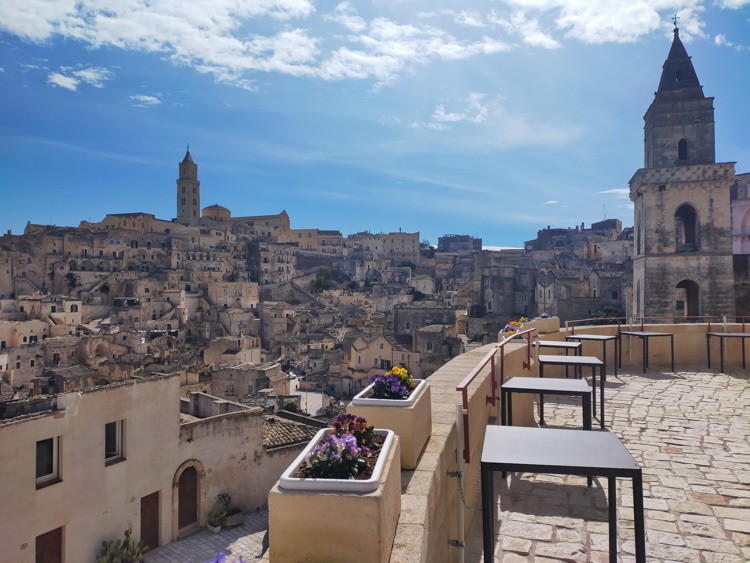 Sasso Barisano. Image by Camilla Zerr
Sasso Barisano. Image by Camilla Zerr
Matera: Old and New Intertwined
Perhaps this portrays how the old and the new are becoming intertwined in Matera. Although, the piazza’s peaceful nonchalance on this early March morning felt aeons away from the tension of a James Bond chase scene.
I admit that the striking beauty of Matera in No Time To Die is what originally put this town on my radar. However, during my stay, I became captivated by a place that’s brimming with history, both ancient and modern.
Matera is a town in Italy’s southern region of Basilicata and is thought to be the third oldest continuously inhabited city in the world. Even though it is a less well-known spot in Italy (for now), Matera won the European Capital of Culture 2019, and its cave houses obtained UNESCO World Heritage status in 1993.
Standing at one of the many viewpoints of Matera’s old town, it almost looked as if the streets and houses had been carved out of the hillside.
This felt improbable to a mind that’s used to the idea of houses being built upwards. But a nearby information board confirmed my first impression: the old town had been carved out of the rock over thousands of years.
This is called negative architecture, or architecture by subtraction. It also explains the name for the two main parts of the old town: Sasso Barisano and Sasso Caveoso, known together as the Sassi di Matera, “sasso” literally meaning stone.
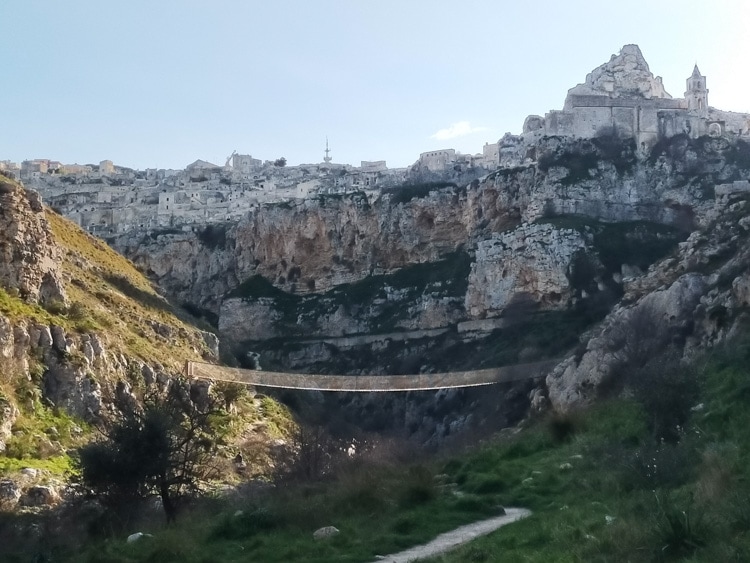 Ponte Tibetano della Gravina (Bridge over the Gravina River). Image by Camilla Zerr
Ponte Tibetano della Gravina (Bridge over the Gravina River). Image by Camilla Zerr
The Resourcefulness of the Materani People
Furthermore, it wasn’t only houses that Materani people dug out of the rock: it was also 150 churches and complex irrigation systems, including snow caves and cisterns for water storage.
The most remarkable of the latter is 16 metres deep and 50 metres long “Palombaro Lungo” (that’s as long as an Olympic swimming pool, but over five times deeper), dating from the 16th century. This mega cistern was only re-discovered in 1991 and is heralded as a feat of engineering.
Materani resourcefulness didn’t stop, or start, there. From the 9th to 19th century, historical records and excavations show that the community lived with sustainability and self-sufficiency at its heart.
They channelled spring and rainwater in an arid landscape for humans and animals respectively. Food was also shared, including the Matera bread with its unique horn shape, baked slowly in shared ovens so that it would stay fresh for longer.
Plus, they repaired and reused materials and tools. Matera’s UNESCO listing itself says: “This is the most outstanding, intact example of a troglodyte settlement in the Mediterranean region, perfectly adapted to its terrain and ecosystem.”
 View across the Sassi towards Matera cathedral. Image by Camilla Zerr
View across the Sassi towards Matera cathedral. Image by Camilla Zerr
Forgetting 9,000 Years
However, when we visited a museum of a typical “cave house”, the focus was mainly on the extreme poverty in which the Materani lived in the early 1900s.
They had very poor sanitation, high humidity, practically no natural light and high infant mortality rates. In addition, hens, pigs and donkeys shared the same one room with a family of 6 or more.
This reminded me of jarring descriptions of Matera as a national embarrassment and the shame of Italy, seemingly losing sight of the fact that people lived here successfully for 9000 years.
Then, the Italian government passed a law in 1952 to evacuate and relocate Materani peasants into modern housing – and I couldn’t help but wonder how they felt about this.
Researching further, I discovered that these caves were never meant to be homes. They were ingeniously carved out of the rock and used for many years as caves to store foods and used as workshops to produce goods such as olive oil, wine and cheese.
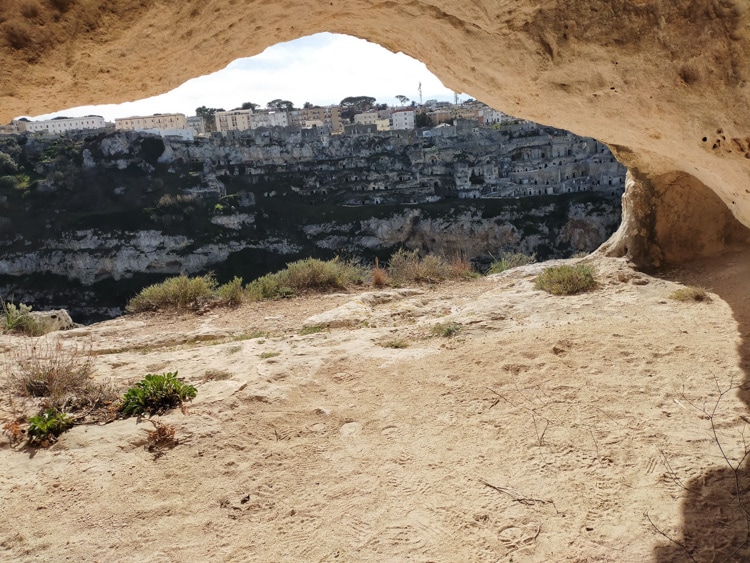 Looking back towards Sasso Caveoso from a cave on the other side of the Gravina ravine. Image by Camilla Zerr
Looking back towards Sasso Caveoso from a cave on the other side of the Gravina ravine. Image by Camilla Zerr
Extreme Poverty Pushed the Materani Into “Cave Houses”
Sadly, due to historical events beyond the control of Matera’s peasant population, the land on which their livelihoods depended was taken away and levels of extreme poverty rose throughout southern Italy. Causes for this included the moving of the capital of Basilicata from Matera to Potenza in 1806.
Also, the loss of agricultural fields rented from the Catholic church when these were sold off during Italy’s political unification in 1841-1871 and the Industrial Revolution likely leaving small-scale food producers struggling to keep up. Plus, the economic impacts and trauma of World Word II.
With no more land to live on and cultivate, many Materani peasant families became homeless and the caves they had made for food storage and production became useless.
Therefore, they started using these caves as shelters and dug deeper to make them big enough to live in. But this damaged some of the underground water channels and cisterns of drinking water that had also been carved into the rock, in turn leading to poor sanitation.
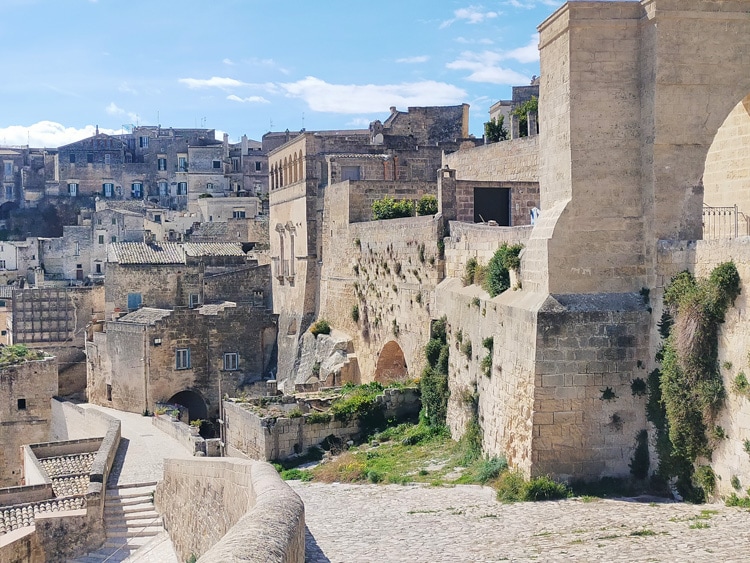 Sasso Barisano. Image by Camilla Zerr
Sasso Barisano. Image by Camilla Zerr
The Failure of La Martella
During our tour of the “cave home”, we were told that despite these conditions, most Materani people living here didn’t want to leave their homes and community. However, I also read about children who were “so happy [about the relocation] that they jumped on the bed.”
Furthermore, I discovered that Matera became known as an “urban planning laboratory” in the 1950s, driven by the idea that architectural design could help rebuild post-fascist, post-war communities.
So in building the village of La Martella, 7 km from Matera, for the relocation of some of the people from the Sassi, the motivation was to reproduce their community spirit, alongside aiming to alleviate poverty by modernising rural life.
But it seems that despite these efforts, not enough land was provided for farming and the communal spaces didn’t flourish as planned.
The lack of success in La Martella led to the next relocation projects becoming more urban: Spine Bianche and Borgo Venusio, for example, were primarily built as apartment blocks within Matera.
It was difficult to find any first-hand stories from people who lived through this relocation: stories that I felt were missing to truly understand what Matera’s Sassi represents.
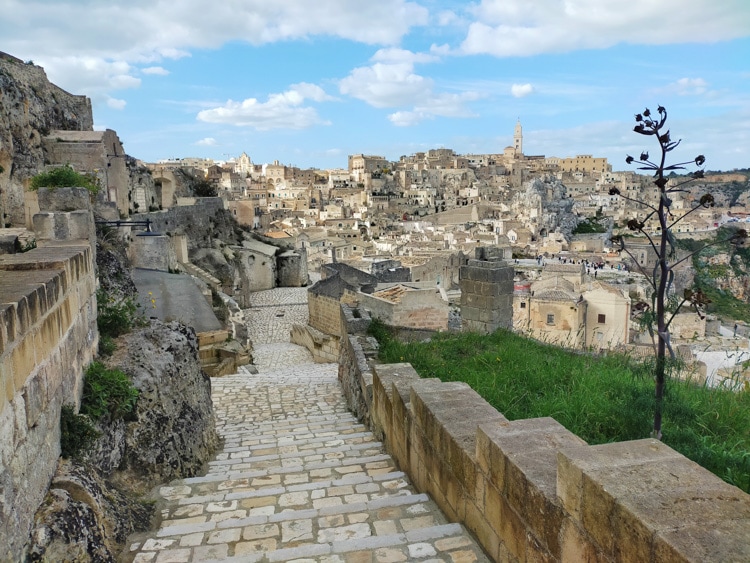 View from Sasso Caveoso towards Matera cathedral. Image by Camilla Zerr
View from Sasso Caveoso towards Matera cathedral. Image by Camilla Zerr
Circolo Culturale La Scaletta Brings Hope to Matera
“In fact, it was not simple, but you would need a whole other article for this!” exclaimed Valentina Zattoni from Matera’s cultural charity Circolo La Scaletta. Today, it seems that most cultural historians don’t support this forced relocation, even though no official apology has been given.
It’s heartening, therefore, that current Materani leaders seem committed to bringing tourism to Matera without letting it hollow out this rich, soulful, rugged place.
Groups such as Circolo Culturale la Scaletta are also playing an important role in valuing and campaigning for the recognition of Matera’s past and present, including a book they published in 1966, which was the first to describe more than 100 rupestrian churches in and around Matera and became the basis for their lobbying.
What stayed with me from Matera’s Sassi was a sense for what a place with meaning feels like. Mario Rodríguez put this feeling into words much better than I could, even translated from Italian, in a recent edition of the Quaderni de la Scaletta: “Here, walking [in the Sassi of Matera], the sensation I felt was that of walking in a place full of a past that does not pass away.” Every street, every church, every rock has been shaped over and over by people and time for more than 9000 years.
As I watched the sunset from the old town’s cathedral piazza one evening, I felt an impulse to seek out more places like Matera that are alive with history, stories, meaning and community, both old and new.
Perhaps one day, I may even be lucky enough to become part of a beautiful, self-sufficient community. But for now, my mind was tugged back to my gelato alla nocciola (hazelnut ice cream) and to all the different shades of orange spreading across the Materani sky.
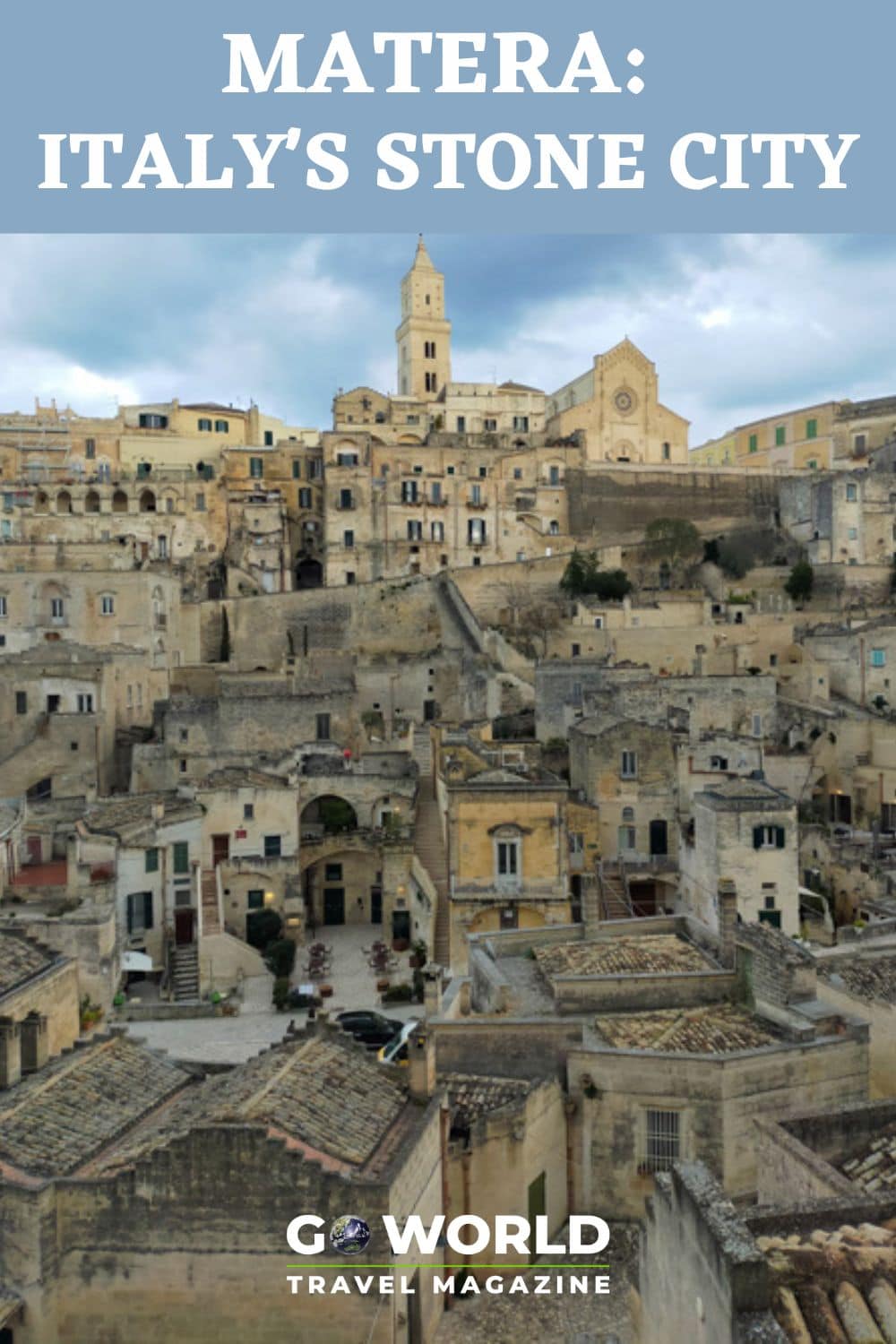
If You Go
- Matera is easily accessible from Bari airport, it’s only 1h 15 away. You can book a coach here: https://www.omio.co.uk/ Do make sure you book a ticket in advance, we saw people who were unable to get on the coach because they hadn’t bought a ticket and you can’t buy a ticket from the coach driver.
- The Tourist Information office on Piazza Vittorio Veneto will provide you with maps and suggested routes to visit the beautiful Sassi de Matera for free and answer all your questions. Piazza Vittorio Veneto is also a key departure point for many guided walking tours. However, we found that walking around the old town at our own pace and getting lost in all the winding streets was a wonderful way to explore.
- There is a bus that drives up and down the only road where vehicles are allowed in the Sassi, called Linea Sassi. It costs 1.50 euros and comes every 20 minutes. https://www.isassidimatera.com/indicazioni/ingresso/
- If you’re looking to treat yourself, don’t miss out on the underground Roman-themed thermal baths carved out of the rock at Locanda Di San Martino. https://www.locandadisanmartino.it/en/home/
Author Bio: Camilla Zerr is an English-French environmental campaigner who lives for nature adventures and spontaneous heart-to-hearts with people from all around the world – and then writing all about it. She campaigned as part of environmental charities for 8 years and is now lucky to be able to take a break from work to travel around Europe by train and (hopefully) realise her dream of seeing a jaguar in the wild in South America. Her favourite place to be is sitting in a tree above water.
[ad_2]
Source link
Jarastyle – #Journey #Present #Italys #Stone #City
Courtesy : https://www.goworldtravel.com/matera-stone-city-italy/?utm_source=rss&utm_medium=rss&utm_campaign=matera-stone-city-italy

